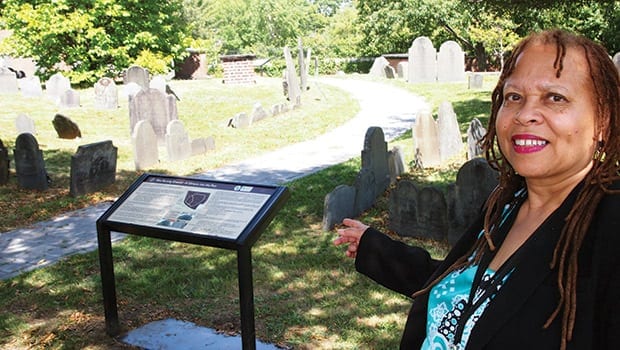Renovated Eliot Burying Ground Opens
Historic Roxbury site open 24/7 after long period of restricted visitation

Thanks to current renovations, Eliot Burying Ground is looking especially tidy. A new cement paver path cuts through the grass, the trees have been pruned, and along Washington and Eustis streets the fence has been restored and some of the wall has been re-pointed. Several new plaques recount the rich history, illustrated by maps and photos.
Despite all the renovations and history, the one thing the graveyard had lacked was visitors. A stone wall topped with a black iron fence circles the burying ground and for a long time, the gate was firmly locked against drop-by visitors. Visitors could only gain access if they submitted a request 24 hours in advance.
All that changed last Friday, August 14th when the Boston Parks and Recreation Department officially opened the Burying Ground 24/7.
“As part of an effort to increase visitation, the site is no longer being locked. If this creates unsafe circumstances, we will have to look for other solutions,” said Ryan Woods, Director of External Affairs for the Department.
The Massachusetts Executive Office of Energy and Environmental Affairs Signature Urban Parks Program grant that funded the renovations stipulates that the grounds be kept open, said Kathy Kottaridis, executive director of Historic Boston Incorporated.
Prior to Friday, there was debate over when and how the cemetery should be opened once renovations finished. The plaques serve little purpose with no one to read them, and the cemetery is an important piece of local history. However, past experiences had made many wary of simply throwing the gates open.
“I think it should be open,” said Joyce Stanley, executive director of Dudley Main Streets and a member of the Roxbury Historic Society. “I think people need to come and see their history. Of course you can’t just leave everything open because things are fragile, but schools should come here, and people from the neighborhood who live here should come.”
In the past, the cemetery has suffered from vandalism. Earlier plaques were defaced and the place was once a popular site to do drugs and drink. The gravestones are so fragile that taking rubbings is explicitly forbidden
State Representative Byron Rushing credits Eliot Burying Ground’s exceptionally good preservation in part to the fact that the grounds haven’t been opened on a regular basis.
Rushing favors opening the graveyard on specific days like Patriot’s Day when high numbers of visitors are likely, so long as someone is appointed to monitor. Another possibility, he said, is to assign responsibility to the adjacent Fire Station or, when it opens, the Nawn Factory, for providing access and ensuring that everyone who enters exits.
There are certain to be visitors, particularly decedents of those buried on the grounds, said Rushing. Among the notables interred there are members of the Pierpont family, whose descendants founded Yale University and JP Morgan Chase; John Eliot, the Puritan missionary known for translating the Bible into Algonquian, and members of the family for whom the nearby; Dudley Square is named.
Rushing noted that one of the reasons Roxbury history is also appreciated by those whose ancestors are not from the area is due to sites like Eliot Burying Ground that serve to pass on the knowledge of what the area was once like.
Founded in 1630, Eliot Burying Ground is one of the oldest historic cemeteries in Boston. While other historic cemeteries have moved gravestones from the original locations, Eliot is one of the few to have largely resisted reorganizing. (A few gravestones have been moved to make room for paths). The grounds also hosts Roxbury’s oldest human-made structure to still survive about ground: the tombstone of a child who died in the mid-1600’s.
Eliot Burying Ground also played a role in the Revolutionary War, when it was used to protect the living as well as the dead. Knowing that any Redcoats riding out of Boston would have to cross through the site, colonists built fortifications there to protect the entrance to Roxbury and the road to Dorchester.
The cemetery, said Stanley, serves to “tell us about our history — Roxbury history, American history,” adding that the graveyard and similar historical sites reflected the fingerprint of each group who lived in Roxbury, from the Puritans on. “Every group leaves their mark,” she said. “Every person that comes — every group that comes — to an area leaves something of themselves there.”






